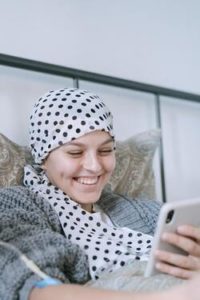Chemotherapy in the bigger picture of cancer treatment
Cancer is traditionally treated with three “modalities”: surgery, radiation, and chemotherapy. In the dark humor of oncology these are called:
- Slash
- Burn
- Poison
Be careful not to take these literally. Surgery is not random slashing, but selected removal of diseased tissue and some healthy tissue. Radiation treatment isn’t blunt burning, but targeted direction of ionizing radiation to areas of the body with malignant cells in the hope that the cells will be killed or rendered unable to reproduce. Chemotherapy isn’t just poisoning with intent to harm the whole body; it is applied to destroy malignant cells or stop the cancer from propagating.
Other therapies we discuss on this website could be considered chemotherapy. Thirty years ago chemotherapy meant use of cytotoxic medicines. When kinase inhibitors first hit the market, some did not consider them chemotherapy. Today all sorts of targeted therapies including immunotherapy fall under the umbrella of chemotherapy.
Combination Therapy
Combination therapy just means more than one modality is used, and it is very common. The patient might have surgery and radiation, or radiation and chemotherapy, or all three. Combination therapy is distinct from combination chemotherapy which means more than one type of chemotherapy agent is administered. Clinicians have come up with all sorts of regimens to treat patients – adjuvant chemotherapy is when the drugs are given after the surgery or radiation, neoadjuvant chemotherapy is when they are given in advance of the main treatment. It is also common for a patient to receive cytotoxic chemotherapy and immunotherapy together.
Half of patients who develop cancer get some form of chemotherapy treatment. Most chemotherapy drugs kill cancer cells outright, or stop their reproduction and spread by inhibiting metabolic functions of the cancer cell. These drugs are called cytotoxic. They can also act on healthy cells (because they also divide) which is the basis for side effects and unwanted complications of therapy.
Apoptosis is a fancy word for cell death. There are actually two words for cell death – necrosis which is when the cell is damaged and apoptosis which is a more natural form of cell death in healthy tissue. Cancer resists apoptosis so drugs that kill cells are used as chemotherapy. The challenge is to find some way cancer cells are different from healthy cells and to design a drug that exploits that difference.
Cytotoxic therapy
At one time all chemotherapy for cancer was cytotoxic, meaning it destroyed cells. Cancer cells multiply faster than healthy ones, so if a drug could kill multiplying cells it preferentially eliminated cancerous cells. While this process worked, it is a blunt tool for attacking cancer, and resulted in side  effects which were often debilitating. At Callaix we sometimes refer to the cytotoxic drugs as “old style” chemotherapy, but that is not intended as an insult. The drugs were often invented years ago (and are no longer under patent protection) and work through a cytotoxic mechanism, but oncologists still use these medicines.
effects which were often debilitating. At Callaix we sometimes refer to the cytotoxic drugs as “old style” chemotherapy, but that is not intended as an insult. The drugs were often invented years ago (and are no longer under patent protection) and work through a cytotoxic mechanism, but oncologists still use these medicines.
Alkylating agents attack cancer at the chromosomal level: they react directly with molecules in the nucleus and cause cell death. Like most conventional chemo agents they are cytotoxic and work mostly in the reproductive phase of the cell’s life. Anthracyclines are derived from bacteria are likewise cytotoxic and work in every phase of the cell cycle. Plant-derived drugs such as paclitaxel and the vinca alkaloids work in the mitotic phase of reproduction.
Gene therapy
Gene therapy is on the cutting edge of medical treatment, and has had success in only a few niches. However, its intellectual appeal is such that it continues to attract research. Cancer is essentially a genetic disease, in that all cancer cells have some alteration of gene expression. While drug therapy goes after the effects of the errant genes, gene therapy changes the genes themselves. More on gene therapy
Targeted chemotherapy
Kinase inhibitors and other signal transduction inhibitors were introduced in the 21st Century and overcame a major limitation of earlier chemotherapies: they discriminate between normal cells and cancerous ones on the basis of cellular metabolism, and their use leads to fewer off-target effects. Kinase inhibitors are generally less toxic than the older generation of chemotherapy drugs.
The names of these drugs often end in “-mab” or “-ib”. MAB stands for monoclonal antibody, and these drugs are used when receptor targets are overexpressed on the outside of cancer cells. The antibodies are too big to go through the cell membrane. The “-ib” drugs, however, enter into the cells and interfere with proteins that cause malignant cells to multiply.